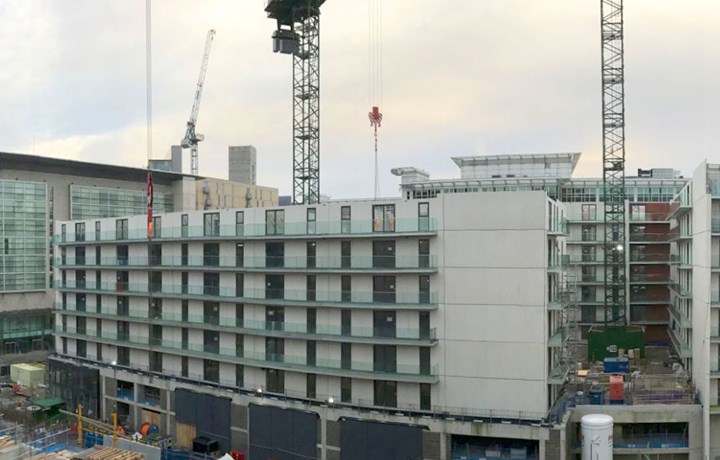Discover how crosswall construction is revolutionising British architecture with unprecedented strength, speed, and environmental benefits
The Evolution of Modern Construction Methods
The UK construction industry stands at a pivotal moment as it grapples with unprecedented challenges: a pressing need for sustainable solutions, housing shortages, and demanding environmental targets. Crosswall construction has emerged as a groundbreaking answer to these challenges, representing a significant leap forward from traditional building methods. This innovative approach, which utilises precast load-bearing walls positioned perpendicular to a building’s lateral axis, is transforming how we conceptualise and execute construction projects across Britain. With the UK government’s commitment to achieving net-zero carbon emissions by 2050, the construction sector is under immense pressure to adopt more sustainable practices. Crosswall construction, with its efficient use of materials and reduced waste, aligns perfectly with these environmental objectives.
Understanding Crosswall Construction: Core Principles and Components
At its core, crosswall construction represents a sophisticated building system that relies on factory-produced concrete panels carefully engineered to form the structural backbone of buildings. These load-bearing walls work in harmony with floor slabs and roof elements to create a robust, box-like structure that excels in both stability and efficiency. The primary components include:
- Precast concrete wall panels, manufactured to precise specifications in controlled factory conditions
- Horizontal floor and roof elements that integrate seamlessly with the vertical walls
- Specially designed connection systems ensuring structural integrity
- Pre-installed service conduits and fixtures embedded during manufacturing
The genius of this system lies in its simplicity and precision. Each component is manufactured off-site under stringent quality control measures, ensuring exceptional consistency and reducing the margin for error typically associated with traditional construction methods.
The Advantages of Crosswall Systems
The adoption of crosswall construction in the UK market has been driven by its numerous compelling benefits. Recent studies indicate that projects utilising crosswall systems have demonstrated up to 30% faster completion times compared to traditional methods. The advantages extend far beyond mere speed:
- Environmental Impact: Reduced waste generation by up to 70% compared to traditional construction
- Cost Efficiency: Labour costs typically reduced by 25-35% due to faster assembly
- Quality Assurance: Factory-controlled production ensures consistent high standards
- Thermal Performance: Excellent U-values and thermal mass properties
- Acoustic Excellence: Superior sound insulation between units
- Fire Safety: Inherent fire resistance of up to 4 hours
Technical Considerations and Implementation
Implementing crosswall construction requires careful attention to technical details and specifications. The success of these systems relies heavily on precise planning and execution. Key technical considerations include structural calculations, thermal performance analysis, and detailed connection design. Projects must adhere to British Standards and Building Regulations, with particular attention to:
- Structural stability and load distribution
- Thermal bridging prevention
- Weathertightness at joints
- Service integration strategy
- Fire resistance requirements
Practical Applications in the UK Market
Crosswall construction has found particular success in specific sectors of the UK building market. The system excels in projects requiring repetitive layouts and standardised units. Notable applications include:
Student Accommodation: Universities across the UK have embraced crosswall construction for new halls of residence, with projects reporting completion times reduced by up to 40%.
Residential Developments: Multiple housing developers have successfully implemented crosswall systems in medium-rise apartment buildings, achieving significant cost savings and improved energy efficiency.
Hotel Construction: Several major hotel chains have adopted crosswall construction for new builds, citing faster return on investment and reduced operational costs.
Overcoming Challenges and Limitations
While crosswall construction offers numerous advantages, it’s essential to acknowledge and address its limitations. The main challenges include:
- Initial design constraints requiring early commitment to layouts
- Higher upfront costs for smaller projects
- Need for specialised installation teams
- Weather-dependent installation process
- Limited flexibility for future modifications
Future Prospects and Industry Impact
The future of crosswall construction in the UK looks promising, with market analysts predicting a 15% annual growth in adoption over the next five years. This growth is driven by several factors:
Increasing emphasis on sustainable construction methods, with crosswall systems offering significant carbon reduction potential. Growing demand for faster, more efficient building solutions to address housing shortages. Advancement in manufacturing technologies enabling more sophisticated precast components. Integration with digital construction technologies, including BIM and automated quality control systems.
Making the Transition to Crosswall Construction
For organisations considering the adoption of crosswall construction, a structured approach is essential. Success requires careful planning and consideration of several key factors:
- Early engagement with manufacturers and specialists
- Comprehensive training for installation teams
- Development of detailed quality control procedures
- Implementation of robust supply chain management
- Investment in appropriate handling and installation equipment
Conclusion: The Role of Crosswall Construction in Sustainable Building
Crosswall construction represents a significant step forward in the UK’s journey toward more sustainable, efficient building practices. While challenges exist, the benefits of reduced construction time, improved quality control, and enhanced environmental performance make it an increasingly attractive option for many projects. As the industry continues to evolve and address current limitations, crosswall construction is poised to play an increasingly important role in shaping the future of sustainable building in the UK. For developers and construction professionals looking to stay ahead of the curve, now is the time to seriously consider this innovative building method.
FAQ
What is an example of a cross wall?
A cross-wall is an interior dividing wall of a castle. It may be an external wall dividing, for example, the inner and outer wards, or it may be a wall internal to a building such as the keep. An example of the external variety is the great cross-wall separating the inner and outer baileys of Conwy Castle in Wales.
What is avoid crossing walls?
Avoid crossing wall Enabling this function allows the nozzle to not cross the outer wall as much as possible when traveling. This can minimize oozing that leads to stringing when crossing the outer wall when printing a layer print of one object.
Sources
[1] https://theconstructor.org/construction/cross-wall-construction-features-benefits/33980/
[2] https://www.concretecentre.com/Building-Solutions/Walls/Crosswall.aspx
[3] https://en.wikipedia.org/wiki/Crosswall_construction


Leave a Reply